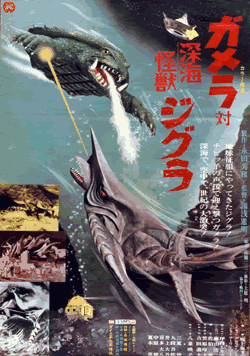- Gamera vs. Zigra
Infobox Film
name = Gamera vs. Zigra

caption = Gamera vs. Zigra (1971) Theatrical poster
director =Noriaki Yuasa
Bret Morrison
producer =Yoshihiko Manabe
Hidemasa Nagata
Sandy Frank (2nd US version)
writer =Nisan Takahashi
starring =Koji Fujiyama
Daigo Inoue
Reiko Kasahara
Daihachi Kita
Goroo Kudan
Shin Minatsu
music =Kenjiro Hirose (Gamera song only)
Shunsuke Kikuchi
cinematography =Akira Uehara
editing =Yoshiyuki Miyazaki
distributor = Daiei, AIP-TV (US TV),Sandy Frank (second US version)
released =July 17 ,1971
runtime = 87 min.
language = Japanese
English
imdb_id = 0067123
amg_id = 1:19179
budget =
preceded_by = "Gamera vs. Jiger "
followed_by = ""nihongo|"Gamera vs. Zigra"|ガメラ対深海怪獣ジグラ|Gamera tai Shinkai Kaijū Jigura|"Gamera versus Deep Sea Monster Zigra" is a
1971 daikaijueiga (giant-monster movie) featuring the popularGamera character created by Daiei Motion Picture Company. "Gamera vs. Zigra" was released in the United States bySandy Frank . It is one of five "Gamera" films featured on "Mystery Science Theater 3000 " (Episode 316, October 19th, 1991).In the film, two children are kidnapped by aliens who are behind a nefarious plot to cause earthquakes around the globe. The children escape and are saved by Gamera, who defeats
Zigra .Zigra
Zigra is an alien monster featured in "Gamera vs. Zigra", the seventh "
Gamera " film. Zigra is a deadly opponent whose appearance is similar to that of aGoblin Shark , possessing a silvery gray, armor-plated hide, a pointed nose, a row of sharp fins on his back, as well as sharp pectoral fins. Unlike most Kaiju, Zigra is intelligent and capable of speech, presumably by telepathic means. He is an alien from an unknown planet that landed on earth via a small spaceship shell -- the ship sports the same dorsal fins. For much of the first half of the film, he uses a captured human female as an extension of his will to infiltrate dry land. The agent (Lora Lee Virus), possesses a symbiotic relation to the ship and also can put humans in a trance by eye contact and snapping her fingers. After the agent was subdued, the shell was destroyed by Gamera, revealing Zigra's full form. Due to differences in Earth's environment to his native planet, Zigra grew in size to match Gamera's.Zigra's combat style, like many Gamera Kaiju, is geared towards melee combat. A brutal opponent, he is capable of firing a silk like spray that can paralyze an opponent, and then follow through with vicious slashes with his sharp fins. Despite an otherwise fish-like appearance, he can exist out of the water, albeit with some difficulty: He was immobilized on the beach until he improvised an awkward standing posture with his tail fins. Zigra invaded earth with the intention of enslaving the human race and raising them like cattle - he came from a planet where instead of people eating fish, fish eat people (thus making the film the first known Japanese instance of the
Russian reversal ). LikeViras attempted three films earlier, Zigra held a pair of human children hostage in order to force the human race to conform to his plan, but Gamera engaged him in battle. Gamera eventually threw him on land, using a rock to play his theme song on Zigra's dorsal fins like a xylophone before setting the alien shark ablaze with his fire breath. In the film "",Zigra fought withGamera again in one of the many "stock footage " scenes. WhenGamera hits his back with the rock, his theme song is not played, and is instead replaced by a new, simple tune.Other Appearances
*Like many of his fellow Showa monsters, Zigra has not made a film appearance outside his initial debut, (except for the obvious stock footage scenes). However, he made an appearance in the "Gamera" comic series by Dark Horse Comics, that was based on the Heisei "Gamera" series. In the story, Zigra was an escaped alien creature from outer space, who managed to find his way onto Earth. He'd eventually meet up and face Gamera, who made relatively short work of him. In this series, he was pretty much unchanged, except for the fact he was more of a wild animal, and was more aquatic-based.
External links
*imdb title|id=0067123|title=Gamera tai Shinkai kaijû Jigura
*
Wikimedia Foundation. 2010.
